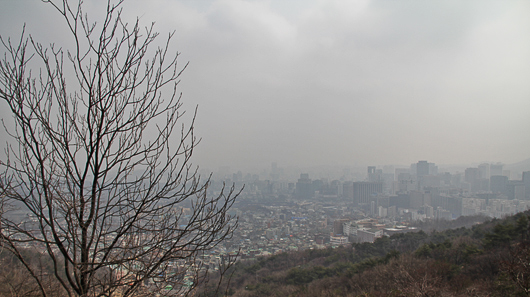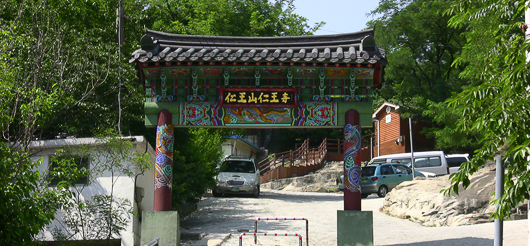6월도 절반이나 지나갔다. 장마가 다가오고 있지만 놀라울 정도로 건조하다. 괜한 입방정을 떨어 비가 쏟아지지는 않았으면 좋겠다. 나는 이런 날씨에 야외활동을 하는 것을 좋아하기 때문이다. 어쨌든 이번 주 다시 한 번 등산을 떠나 보자. 2009년 한국에 왔을 때 내가 처음 올랐던 산이다. 그래서 나에게 특별한 추억으로 남아 있다. 정상에 올랐을 때 풍경은 너무나도 놀라워서 당신을 꼭 그곳에 초대하고 싶다. 많은 동네 주민이 역사성이 있는 서울성벽을 가까이에서 보기 위해 인왕산을 오른다. 하지만 문화적 측면에서 산을 탐사하기 위해 뒷길을 찾는 사람은 많지 않다. 나는 이 경험을 포기하는 것은 거의 죄라고 생각한다. 이 길은 말 그대로 사람들이 덜 찾기 때문이다. 물론 어떤 사람들이 2천5백만 명이 살고 있는 도시를 탈출해 혼자있는 시간을 갖고 싶어서 이 길을 오르는 경우도 간혹 있다. 산행은 지하철 3호선 독립문 역에서 출발한다. 2번 출구로 나와서 인왕산이 아닌 인왕사로 가는 길을 가리키는 표지판을 따라가야 한다. 외국인이라면 착각하기 쉬운 미묘한 차이가 있다. 인왕사는 절을 나타내고 인왕산은 산의 이름이다. 이번 산행에서 인왕사에서 시작해 산을 올라가려고 한다. 오르막을 오르면서 복고풍인 뒷동네를 지나게 될 것이다. 첫인상은 서울의 다른 오래된 동네와 다를 바 없어 보이지만 그렇지 않다. 이 건물들 사이에 아늑하게 자리잡고 있는 보물이 있기 때문이다. 인왕사다. 커다란 종이 정문 바깥에서 절의 입구를 알려준다. 안으로 들어서면 속세를 벗어난 고요함이 느껴진다. 인왕사는 서울의 다른 곳과 사뭇 다르다. 우리 일상 아주 가까운 곳에 있다는 점에서 더욱 특별하다. 국사당은 오래된 사당이다. 원래 남산에 있던 사당은 일제 강점기에 일본이 파괴했다. 여전히 사당을 섬기는 사람들이 1925년에 사당을 재건했다. 그런데 일본이 또 다시 파괴할지도 모른다는 두려움 때문에 현재의 위치에 비밀리에 사당을 세웠다. 덕분에 사당은 불교사원 옆에 평화롭게 공존하게 됐다.
계속 서울 성벽을 찾아 올라가다 보면 다양한 암석군을 지난다. 서울 성벽을 향한 오르막길에서 방문객들은 민족의 과거에 대해 돌이켜 볼 수 있을 것이다. 정상으로 가는 길은 중간 정도 난이도에 가깝지만 남녀노소 누구나 쉽게 완주할 수 있다. 정상에 오르면 아래에 펼쳐진 놀라운 풍경을 감상할 수 있다. 길 중간에 얼마나 많은 것들을 구경했느냐에 따라 차이는 있겠지만 왕복하는 데 두 시간이면 충분하다. 여름에 물을 많이 가져가야 한다. 등산로가 그늘이 적기 때문이다. 땀을 흡수할 수 있는 옷과 모자를 챙기기를 권한다. 짧은 등산이기 때문에 주중에도 충분히 가능하다. 저녁 여덟시까지 해가 떨어지지 않으므로 6시쯤 퇴근해서 오면 적당한 장소에서 일몰을 볼 수 있다. 땅거미가 내린 후 안전하게 하산하기 위해서 손전등을 챙기는 걸 잊지 않길 바란다. 당신이 내가 추천한 등산코스에 함께 하면 좋겠다. 왜냐면 이곳은 서울에서 가장 저평가된 등산로 중 하나다. 만약 당신도 여기 가보면 함께 경험을 나누고 싶을 것이다. 다음 시간까지 새로운 모험을 위한 준비를 하길 바란다.
<원문> We’re halfway through June and despite it being the “rainy season,” it’s been remarkably dry (knock on wood). I really hope I just didn’t jinx myself right there, as I love being outdoors in this kind of weather. So this week on Compass it’s time once more to hit a mountain trail. When I first arrived in Korea in 2009, this was one of the first trails I ascended, so it holds a special memory for me and I hope you’ll take me up on this journey, for at the top, the views are amazing, as it the trek up. While many locals hike Inwangsan (인왕산) to get a closer look at the historic Seoul Fortress wall, many don’t take the “back route” and explore the cultural side of the mountain. I think passing up on that experience is a crime, since after all, it is certainly a road less traveled. Also, since fewer people take this route the chances are slightly better one might get a little “alone time,” which in a city of nearly 25 million, is always appreciated. The hike starts off at Dongninmun Station on Line 3. Saunter out exit 2 and look for the signs pointing the way to Inwangsa (인왕사) not Inwangsan (인왕산). It’s a subtle difference to English readers and speakers, but the former denotes a temple and the latter the mountain’s name. For this hike, we want to start off on the temple side of things and work our way up. Walking up the hill, you’ll find yourself navigating the small backstreets of a quaint neighborhood. At first glance, it isn’t anything different than any older portion of Seoul, but you’d be wrong. Nestled among these buildings is a great hidden treasure: Inwangsa. The large bronze bell that sits outside the main gate marks the temple entrance. Stepping inside, one is transported a world away and calmed. The temple is little different from others in Seoul, but what makes this one unique is what’s just around the corner. Guksadang (국사당) is an old shamanistic shrine. The original shrine was built on Namsan Mountain, but the Japanese destroyed it and other shrines during the colonial period. Those still holding to their beliefs rebuilt the shrine in its current location some time after 1925 in secret, fearing the Japanese would destroy it again. Ever since then, the shrine has peacefully coexisted next to the Buddhist temples. Continuing upwards, hikers pass various rock formations before finding the historic Seoul Fortress wall. Making the climb upwards rewards visitors with great glimpses into the nation’s past. The hike up to the summit isn’t that difficult and can be easily completed by almost all fitness levels, but closer to the moderate ranking of trails. When there, you’re treated with amazing panoramic views of the city below. Depending on how much sightseeing one does along the way, the entire trek up and back should only take two hours. Bring plenty of water in summer months since the trail is exposed to direct sunlight. I’d also recommend some wicking clothing and a hat. Because the hike is short, this journey is also great during the week. Sunset isn’t until nearly 8pm, so if you’re able to leave the office around 6pm, you can make it to the area and watch the sun set from this ideal location. Just be sure to bring a flashlight so you can safely make it down the mountain if you stay after dusk. I hope you’ll take me up on this hiking recommendation, since I think it’s one of the more underrated trails in Seoul. If you do, be sure to share your experiences with us. Until next time, be sure to keep your Compass set for adventure.
|
|||||||||||||||||||||||||

인사이트
서울에 아늑하게 숨겨진 보석을 찾아
[COMPASS] 저평가된 등산로, 인왕산 뒷길
스티브 밀러 Steve@QiRanger.com |
입력 :



